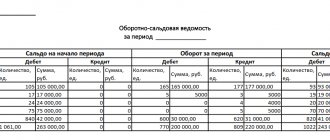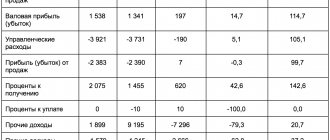What is what
Don't know what an off-balance sheet account is in accounting?
In the working charts of accounts used in accounting in both budgetary and commercial and non-profit organizations, main (balance sheet) and off-balance sheet accounts are distinguished. On the main accounts, accountants must conduct transactions related to the movement of cash and other material assets, receipts and disposals, profits and mutual settlements with counterparties; information about various goods and works, as well as advertising and other services are taken into account. Off-balance sheet accounts are used to account for inventory items that are temporarily at the disposal of the organization and do not belong to it as property. Off-balance sheet accounts are also needed to reflect transactions on those obligations that are awaiting fulfillment, and the movement of values not intended for accounting on the main accounting accounts. Such accounts are auxiliary accounting accounts. The balances for them are not included in the balance sheet and are illustrated behind the results of the main balance sheet, that is, behind the balance sheet. They do not affect the financial result and are not reflected in the periodic and final reports of the organization.
Balance sheet accounts are opened by enterprises for the following cases:
- Keeping records of property that either does not belong to him or is written off as expenses.
- Collection of information that must be indicated in the subject of the explanatory note to the balance sheet and final reporting.
Off-balance sheet accounts in budgetary institutions in 2021 are regulated by the Chart of Accounts approved by Order of the Ministry of Finance of the Russian Federation No. 157n dated December 1, 2010 (Instruction No. 157n). The procedure for maintaining balance sheet accounting for non-profit organizations is established by Order of the Ministry of Finance of the Russian Federation No. 94n dated October 31, 2000. They are also regulated by 402-FZ “On Accounting” dated December 6, 2011 and the Civil Code of the Russian Federation. Having these legal acts at hand, it is much easier and clearer to conduct accounting for off-balance sheet accounts.
When is it impossible to transfer property from off-balance sheet accounts 03 and 07?
The answer is obvious - when it does not satisfy at least one of the conditions listed above.
Let's take a closer look at examples.
Example 1. In the accounting of the institution, fuel cards are taken into account in off-balance sheet account 03 in accordance with the provisions of the accounting policy. There is no need to transfer them from off-balance sheet account 03 to the balance sheet as part of material inventories. The fact is that fuel cards, as a rule, are the property of the company that issued them. Accordingly, they do not satisfy the concept of an asset.
More on the topic: KPS for accounts 0 100 00 000 in 2021
Example 2. In the accounting of the institution on off-balance sheet account 07, certificates acquired in 2014-2015 are taken into account. The institution does not have a warehouse. The certificates are kept by the employees responsible for issuing them. In this case, there is no need to transfer certificates from off-balance sheet account 07 to balance sheet account 105 06.
Features for budgetary institutions
The use of off-balance sheets in the accounting of a budgetary institution is regulated by Instruction 157n (section 7). This section provides a list of assets that should not be included in balance sheet accounts. According to current legislation, institutions have the right to adjust this list and, if necessary, include other inventory items in it.
In accordance with paragraph 373 of Instruction 157n as amended on March 31, 2018, accounting is carried out on off-balance sheet accounts of budgetary institutions:
- valuables located in the organization without the right of operational management (rent, free use, etc.);
- valuables that are taken into account outside balance sheet accounts (fixed assets in the amount of up to 10,000 rubles, strict reporting forms, prizes, vouchers, etc.);
- obligations awaiting fulfillment.
Do you know how many off-balance sheet accounts have existed since 2015? Currently, 31 accounts are used in budget accounting!
You can familiarize yourself with all the accounts that are used when maintaining records in a budgetary institution in the table.
| No. ZSCh | Name |
| 01 | "Property received for use" |
| 02 | “Material assets accepted for storage” |
| 03 | "Strict reporting forms" |
| 04 | "Debt of insolvent debtors" |
| 05 | “Material assets paid for through centralized supply” |
| 06 | “Debt of pupils and students for unreturned material assets” |
| 07 | “Awards, prizes, cups and valuable gifts, souvenirs” |
| 08 | "Vouchers unpaid" |
| 09 | "Spare parts for vehicles" |
| 10 | “Ensuring the fulfillment of obligations” |
| 11 | "State municipal guarantees" |
| 12 | “Special equipment for carrying out research work under contracts by customers” |
| 13 | "Experimental Devices" |
| 14 | "Settlement documents awaiting execution" |
| 15 | “Settlement documents not paid on time due to lack of funds in the account of a state (municipal) institution” |
| 16 | “Overpayments of pensions and benefits due to incorrect application of legislation on pensions and benefits, accounting errors” |
| 17 | "Cash receipts" |
| 18 | "Cash Outflows" |
| 19 | “Unexplained budget revenues from previous years” |
| 20 | "Debt unclaimed by creditors" |
| 21 | “OS worth up to 10,000 rubles inclusive in operation” |
| 22 | “Material assets received through centralized supply” |
| 23 | "Periodicals for use" |
| 24 | “Property transferred into trust management” |
| 25 | “Property transferred for paid use (rent)” |
| 26 | “Property transferred for free use” |
| 27 | “Material assets issued for personal use to employees (employees)” |
| 30 | “Calculations for the fulfillment of monetary obligations through third parties” |
| 31 | "Shares at par value" |
| 40 | "Assets in management companies" |
| 42 | “Budget investments implemented by organizations” |
Here are the ones that are most often used in work:
- Property accounting is carried out using 01, 02, 05, 06, 07, 09, 12, 13, 21, 22, 24, 25, 26, 27 off-balance sheet accounts.
- Strict reporting forms, prizes, vouchers and periodicals are reflected in accounts 03, 08, 23.
- Accounting for cash and settlement documents is carried out on accounts 14-19, 30.
- Accounts receivable and payable are posted to off-balance sheet accounts 04 and 20, respectively, guarantees are posted to 10 and 11.
- Financial investments are recorded in 31, 40, 42 off-balance sheet accounts.
Reflection of the transfer of account balances.
Taking into account the changes made to Instruction No. 157n, the working chart of accounts of the autonomous institution has been supplemented with new balance sheet accounts:
Postings in the budget. Table 4
| Account number | Name |
| 205 82 | “Calculations for unidentified receipts” |
| 209 30 | "Calculations for cost compensation" |
| 209 40 | “Calculations on forced seizure amounts” |
| 209 83 | “Calculations for other income” |
| 210 11 | “Calculations for VAT on advances received” |
| 210 12 | “Calculations for VAT on purchased material assets, works, services” |
| 401 60 | “Reserves for future expenses (by type of expense)” |
| 500 90 | “Authorization for other subsequent years (outside the planning period)” |
| 502 07 | "Obligations accepted" |
| 502 09 | "Deferred obligations" |
Thus, as new accounts are introduced, it is necessary to record the transfer of balances in these accounts.
In accordance with clause 4 of the Methodological Recommendations, the transfer of account balances in terms of income calculations is carried out on the basis of a certificate (form 0504833) reflecting the following accounting entries:
Budgetary accounting entries. Table 5
| Contents of operation | Debit | Credit |
| Reflects the transfer of balances in the amount of debt for damage subject to compensation by court decision in the form of compensation for expenses associated with legal proceedings (payment of state fees, payment of legal costs)* | 0 209 30 000 | 0 205 30 000 |
| The transfer of balances in the amount of debt for compensation of damages is reflected in accordance with the legislation of the Russian Federation, including in the event of insured events* | 0 209 40 000 | 0 205 40 000 |
| Reflects the transfer of balances in the amount of debt on fines, penalties and penalties accrued for violation of the terms of contracts for the supply of goods, performance of work, provision of services* | 0 209 40 000 | 0 205 40 000 |
| The transfer of balances in the amount of debt for the sale of property is reflected due to the decision to write off non-financial assets (scrap metal, rags, waste paper, other waste and (or) objects obtained during dismantling (dismantling) of written-off, liquidated objects)* | 0 209 74 000 | 0 205 74 000 |
| Reflects the transfer of balances in the amount of debt for other income not related to the implementation of contracts, agreements, including the provision of subsidies, as well as the performance by the institution of the functions assigned to it in accordance with the legislation of the Russian Federation* | 0 209 83 000 | 0 205 80 000 |
| Reflects the transfer of balances in the amount of debt on accrued interest for the use of other people's funds due to their unlawful retention, evasion of their return, other delay in their payment or unjustified receipt or savings, as well as charges for compensation of lost benefits* | 0 209 83 000 | 0 205 80 000 |
| Reflects the transfer of balances in the amount of debt for unidentified receipts* | 0 205 81 000 | 0 205 82 000 |
| Reflects the transfer of balances in the amount of calculations for tax deductions for VAT in terms of the tax accrued upon receipt by the taxpayer of payment, partial payment for upcoming deliveries of goods (performance of work, provision of services)* | 0 210 11 000 | 0 210 01 000 |
| Reflects the transfer of balances in terms of tax amounts presented to the taxpayer when purchasing goods (work, services) subject to deduction* | 0 210 12 000 | 0 210 01 000 |
* If, on the date of transition to the application of the provisions of Order of the Ministry of Finance of the Russian Federation No. 89n, there are credit balances for calculations in terms of the indicated income, the transfer of calculation indicators is carried out by reverse correspondence, similar to those given above.
After carrying out the inventory in the AU, account 2,210,01,000 “Calculations for VAT on purchased material assets, works, services” listed the total amount of input VAT - 25,678 rubles, which, according to tax accounting data, consisted of two amounts:
- the amount of tax accrued upon receipt by the taxpayer of payment, partial payment on account of upcoming deliveries of goods - 5,325 rubles;
- the amount of tax presented to the taxpayer upon the purchase of goods (work, services) subject to deduction - 20,353 rubles. The transfer of balances was issued with a certificate (f. 0504833).
The following entries were made in the accounting records of the AU:
Budgetary accounting entries. Table 6
| Contents of operation | Debit | Credit | Amount, rub. |
| The transfer of VAT balances on prepayment is reflected | 2 210 11 000 | 2 210 01 000 | 5 325 |
| Reflects the transfer of balances regarding input VAT when purchasing goods from suppliers | 2 210 12 000 | 2 210 01 000 | 20 353 |
In accordance with clause 4 of the Methodological Recommendations, the transfer of account balances in terms of settlements of obligations is carried out on the basis of a certificate (form 0504833) reflecting the following accounting entries:
Table 7
| Contents of operation | Debit | Credit |
| Regarding settlements of obligations | ||
| Reflects the transfer of balances in the amount of debt to the institution for advance payments under agreements, state (municipal) contracts, not returned by the counterparty in the event of their termination, including by court decision, when conducting claims work | 0 209 30 000 | 0 206 00 000 |
| Reflects the transfer of balances in the amount of debt to the institution for the listed security for applications for participation in a competition or closed auction, security for the execution of contracts, state (municipal) contracts, other collateral payments, deposits | 0 210 05 000 | 0 206 00 000 |
| The transfer of balances is reflected in the amount of debts of accountable persons not returned in a timely manner (not withheld from wages), for which claims work is being carried out as of the date of transfer, including in the case of a challenge by an individual debtor of the deductions, as well as for employees with whom employment relations have been terminated | 0 209 30 000 | 0 208 00 000 |
| Reflects the transfer of balances in the amount of debt for payments of benefits, pensions, compensations not received in a timely manner by the recipients of these payments | 0 302 00 000 | 0 304 02 000 |
| The transfer of balances in the amount of damage in the amount of debt of former employees for unworked vacation days upon their dismissal before the end of the working year for which they already received annual paid leave, identified during the inventory, is reflected* | 0 209 30 000 | 0 401 10 130 |
* With simultaneous reflection of corrective accounting entries for the corresponding settlement accounts 0 302 00 000 “Settlements for obligations”, 0 303 00 000 “Settlements for payments to budgets”.
Procedure for maintaining off-balance sheet accounting
Maintaining off-balance sheet accounting ensures control over the use and safety of valuables that are in temporary possession of the institution, as well as timely and correct execution of the relevant accounting documentation and the organization of proper off-balance sheet accounting.
Off-balance sheet accounting is carried out in a simple form, avoiding spam, that is, amounts for transactions with assets taken off-balance sheet are reflected either as a debit or as a credit. There is no correspondence (double entry) regarding them.
Postings are compiled according to the following rule: the required amount is recorded either in Dt or in Ct. The same operation should not be carried out on the debit of one account and on the credit of another. On the off-balance sheet Dt, accounting records are formed for the receipt of property and the issuance of security, on the Kt - the disposal of valuables and the completion of security.
The balance at the beginning of the period (month) indicates the presence of one or another type of value that is accounted for in a certain account. The balance at the end of the month for the client is always in debit.
The debit balance at the end of the period determines the balance of funds formed at the reporting date.
Mastering targeted subsidies: accounts and postings
Let's say a budgetary institution received a targeted subsidy for the installation of a fire escape.
In this case we will use the following wiring:
1. Reflecting the institution’s acceptance of a budgetary obligation (under an agreement with the enterprise that will install the ladder):
- Dt 5 506 10 225;
- Kt 5 502 11 225.
We chose account 5 506 10 225 because its structure contains the following codes:
- 5 - financial support code (in this case - subsidy);
- 506 - a synthetic code according to the Chart of Accounts, reflecting the fact that we are talking about the exercise of the right to receive obligations (this right can only be exercised by budgetary and autonomous institutions);
- 10 - analytical code according to the Chart of Accounts, reflecting the fact that the assumed obligations relate to the current financial year;
- 225 - KOSGU code, reflecting the fact that the institution orders work and services for maintaining property in the form of installing a fire escape.
We chose account 5 502 11 225 because its structure contains a code of the form 502 - a synthetic code reflecting the fact that the institution has accepted budgetary obligations.
2. Reflecting the institution’s acceptance of a financial (monetary) obligation (upon completion of work and receipt of documents for payment):
- Dt 5 502 11 225;
- Kt 5 502 12 225.
We used account 5,502 11,225 for the same reason as in the previous posting.
Account 5 502 12 225 is used by us because it includes codes:
- 502 - reflecting the fact that the institution has accepted financial obligations;
- 12 - reflecting the fact that the liabilities relate to the current financial year.
Accounting object “income” from 2021
According to clause 37 of the GHS “Revenue”, the object of accounting for other income from non-exchange transactions are certain types of receipts from non-exchange transactions, taking into account their intended purpose (conditions for the transfer of assets), based on the economic content of non-exchange transactions according to the budget classification of the Russian Federation. For example, such income includes grants, subsidies (with the exception of subsidies for the implementation of government tasks), donations, and gratuitous receipt of property.
Starting from 2021, income accounting is carried out in accordance with the GHS “Income” in the context of income from exchange and non-exchange transactions. The standard provides criteria and features for the recognition and assessment of certain types of income. However, the standard does not apply to income received from the sale of non-financial assets due to changes in the value of assets and liabilities, exchange rates and other similar income.
Insurance payment and offset of the policyholder's debt
At the discretion of the insurance company and unless otherwise provided by the accounting policy, the amount of insurance payment directly transferred to the policyholder may be reduced in connection with offsetting the company's debt. In other words, if an individual has a debt to the insurer (most often for monthly payments), then upon the occurrence of an insured event, such person receives a payment minus the existing debt. This operation can be carried out only with the consent of the policyholder (based on an application certified by his signature).
Example No. 1.
06/08/2015 between the insurance company “Zashchita Plus” and the individual Korolev N.L. an insurance agreement was concluded for personal property (apartment), according to which Korolev pays monthly insurance premiums in the amount of 2,880 rubles. On 10/05/2015, an insured event occurred with Korolev, as a result of which material damage was caused to the apartment. Based on the incident, an insurance certificate was issued for compensation in the amount of 57,850 rubles. At the same time, Korolev sent an application to Zashchita Plus with a request to make a payment taking into account the subsequent monthly payment under the contract.
The application was accepted, as a result of which the Zashchita Plus accountant made the following entries:
| Debit | Credit | Description | Sum | Document |
| 22.1 | 51 | Funds were transferred to Korolev to pay off debt on insurance payments (RUB 57,850 – RUB 2,880) | RUR 54,970 | Insurance contract, Insurance act, Payment order, Payment order |
| 22.1 | 77.1 | The amount of the monthly insurance payment is offset against the amount of compensation due to Korolev | RUB 2,880 | Insurance contract, Insurance act, Application |









